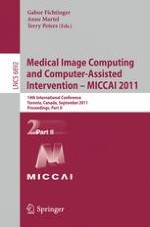2011 | OriginalPaper | Chapter
Reconstruction of Fiber Trajectories via Population-Based Estimation of Local Orientations
Authors : Pew-Thian Yap, John H. Gilmore, Weili Lin, Dinggang Shen
Published in: Medical Image Computing and Computer-Assisted Intervention – MICCAI 2011
Publisher: Springer Berlin Heidelberg
Activate our intelligent search to find suitable subject content or patents.
Select sections of text to find matching patents with Artificial Intelligence. powered by
Select sections of text to find additional relevant content using AI-assisted search. powered by
White matter fiber tractography plays a key role in the
in vivo
understanding of brain circuitry. For tract-based comparison of a population of images, a common approach is to first generate an atlas by averaging, after spatial normalization, all images in the population, and then perform tractography using the constructed atlas. The reconstructed fiber trajectories form a common geometry onto which diffusion properties of each individual subject can be projected based on the corresponding locations in the subject native space. However, in the case of High Angular Resolution Diffusion Imaging (HARDI), where modeling fiber crossings is an important goal, the above-mentioned averaging method for generating an atlas results in significant error in the estimation of local fiber orientations and causes a major loss of fiber crossings. These limitatitons have significant impact on the accuracy of the reconstructed fiber trajectories and jeopardize subsequent tract-based analysis. As a remedy, we present in this paper a more effective means of performing tractography at a population level. Our method entails determining a bipolar Watson distribution at each voxel location based on information given by all images in the population, giving us not only the local principal orientations of the fiber pathways, but also confidence levels of how reliable these orientations are across subjects. The distribution field is then fed as an input to a probabilistic tractography framework for reconstructing a set of fiber trajectories that are consistent across all images in the population. We observe that the proposed method, called
PopTract
, results in significantly better preservation of fiber crossings, and hence yields better trajectory reconstruction in the atlas space.
